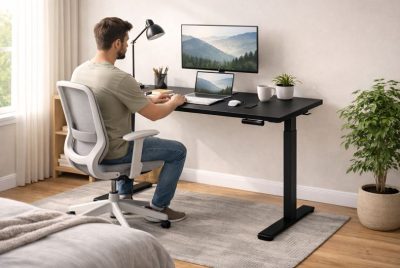10 Car Ergonomic Hacks That Actually Work + Handpicked Ergonomic Products
We may earn a commission for purchases made using our links. Please see our disclosure to learn more.
Let’s be honest. We often spend more time driving than we realize. Whether you’re commuting, dropping off kids, or going on a road trip, long hours behind the wheel can wear you down. You start to feel stiff, sore, and tired. Over time, that discomfort builds up. It can lead to poor posture, back pain, and fatigue that lasts even after the drive ends. But there’s a solution. Car ergonomic tips can help. With a few simple changes, you can make your car more comfortable and body-friendly. In this guide, you’ll find 10 easy hacks that actually work, plus handpicked products to help you get started.
Scientific Studies That Validate These Ergonomic Hacks
Scientific research strongly supports the importance of proper car ergonomics for driver health and comfort. The Canadian Centre for Occupational Health and Safety’s guide to driving ergonomics outlines essential adjustments for seat height, lumbar support, and mirror positioning to reduce strain and improve posture on the road.
Complementing this, a clinical study on lumbar support customization found that personalized lumbar adjustments significantly lowered discomfort during prolonged driving sessions, reinforcing the value of car ergonomic cushions and seat modifications. These findings validate the hacks shared in this guide, proving small changes can lead to meaningful relief.

1. Adjust Your Seat Like a Pro
Many people drive for years without properly adjusting their seats. Poor placement can result in tense shoulders, hurting backs, and even tingling legs. Here’s how to make it right:
- Your seat height should allow your eyes to be level with the center of your windshield.
- Keep your knees slightly bent and your feet comfortably resting on the pedals.
- Recline the seat back to about 100–110 degrees—not too upright, not too far back.
For deeper ergonomic suggestions, check out this detailed breakdown of top ergonomic car seats that are designed to improve comfort and posture on the road.
2. Don’t Skip Lumbar Support
Lower back pain when driving is more than just bothersome; it indicates that your spine is not properly supported. Many car seats lack proper lumbar curvature, which can result in weariness and pain.
If your seat does not support your spine’s natural S-curve, consider adding external support or simply rolling up a towel and placing it behind your lower back for a quick remedy.
3. Upgrade Your Steering Wheel Comfort
The steering wheel is your principal interface with the road, so it should be as pleasant and supportive as your seat. A poorly constructed or difficult-to-grip wheel can cause tension in the hands, wrists, and even shoulders.
To avoid this, use a relaxed grip and ensure your hands are naturally resting in the 9-and-3 position.
4. Adjust Mirrors to Encourage Better Posture
Do you ever find yourself leaning forward just to check your side mirrors? That’s a sign your setup isn’t quite right. Adjust all mirrors while sitting in your ideal posture so that you don’t need to tilt or twist to see clearly.
This not only improves comfort but also reduces unnecessary strain on your neck and upper back.
5. Raise Your Rearview Mirror Just a Bit
Here’s a surprisingly simple trick: tilt your rearview mirror just slightly upward. This encourages you to sit a little taller to maintain visibility—promoting better spinal alignment without even thinking about it.
It’s a subtle hack, but one that can make a big difference over time.

6. Use Seat Gap Fillers to Avoid Awkward Movements
How many times have you dropped something between the seat and the center console and had to twist awkwardly to retrieve it?
That kind of movement might seem harmless, but it adds up—especially if you’re driving often. Preventing items from falling in that gap eliminates one more reason to strain or contort your spine.
7. Fix Your Headrest Position
A poorly positioned headrest can push your head forward or offer no support at all. This leads to neck pain and contributes to poor posture over long drives.
To correct it, make sure the middle of your headrest aligns with the back of your head—not your neck—and that it’s close enough to catch your head in case of sudden movement.
8. Stretch Before and After Driving
Being in a static seated position for hours isn’t good for anyone. Even if your setup is perfect, your body still needs to move.
Take five minutes before and after long drives to stretch your neck, back, shoulders, and hips. Not only will you feel looser, but you’ll reduce the risk of stiffness or discomfort later in the day.
9. Use a Footrest or Pedal Extender If Needed
If you’re shorter and find yourself reaching for the pedals, it can pull your whole body forward—ruining your posture. A footrest or pedal extender can help bring the pedals to you so you can sit back comfortably without compromising control.
Even taller drivers can benefit from adjusting foot support to avoid awkward ankle angles during long-distance driving.
10. Mind Your Grip: 9 and 3 Is the New 10 and 2
You may have grown up hearing that “10 and 2” is the safest way to hold the wheel. But times (and airbags) have changed.
Now, most experts recommend “9 and 3” for better control and to reduce the risk of arm injury in case of airbag deployment. This position also promotes a more natural and relaxed posture through your arms and shoulders.
Ergonomic Products for Comfortable Driving
Want to upgrade your setup? Here are some driver-approved tools that can make your daily drive more comfortable and posture-friendly:
Seat Cushions
- Everlasting Comfort Car Seat Cushion – Memory foam design that promotes spinal alignment and reduces pressure on the hips and tailbone.
Lumbar Support
- LoveHome Lumbar Support Pillow – Breathable and adjustable support that fills the natural curve of your lower back.
Steering Wheel Cover
- SEG Direct Microfiber Leather Steering Wheel Cover – Adds comfort, grip, and reduces wrist fatigue.
Seat Gap Filler
- Drop Stop Original Gap Filler – Prevents small items from falling into the seat gap and eliminates awkward reaching.
Neck Support Pillow
- ZATOOTO Car Neck Pillow – Keeps your head and neck aligned during long drives.
Final Thoughts
Driving doesn’t have to mean discomfort. With a few simple tweaks—and the right ergonomic tools—you can transform your car into a body-friendly space. Whether you’re clocking miles for work or running errands around town, prioritizing posture and support pays off in energy, focus, and long-term health. Start with one small change, then build from there. Your spine and your sense of calm will appreciate the change.
FAQs
1. What does “car ergonomic” mean?
It refers to optimizing your car’s interior layout—seat, steering wheel, mirrors, and accessories—for better posture and physical comfort.
2. Can car ergonomics really prevent back pain?
Yes. Proper support for your lower back, neck, and legs can reduce strain, especially on long drives.
3. Are these tips useful for all vehicles?
Absolutely. These hacks apply to sedans, SUVs, trucks, and even work vans.
4. What’s the best first purchase to improve comfort?
A seat cushion or lumbar support pillow offers the quickest and most noticeable upgrade.
5. How often should I stretch during a long trip?
Aim to stop and stretch every 1–2 hours on longer drives to reduce stiffness and increase circulation.




